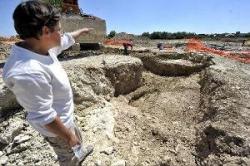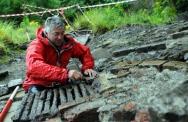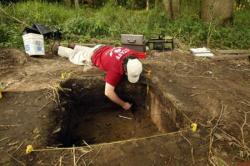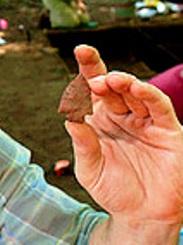- 12 AOÛT
- INDI-UNI : 
PRE-INSCRIPTION : 15 Juin – 15 Août
PRE-REGISTRATION: June 15th - August 15th
- FRANCE –  Saint-Germain-du-Puy - Au lieu-dit « Les Boubards », sur la commune de Saint-Germain-du-Puy, les archéologues fouillent une surface de 2.300 m2 . Ils ont mis au jour une nécropole mérovingienne du VIIe siècle (900 m2), au moins deux carrières de calcaire (500 m2) et quatre fours à chaux présumée. Les fouilles doivent se poursuivre jusqu'au 31 août. Les carrières à calcaire (elles sont deux au minium) étaient situées juste à côté des nécropoles. Elles servaient soit à faire l'intérieur des murs, soit à faire de la chaux pour le lien entre les pierres. La nécropole, elle, contenait environ cent cinquante tombes. Chaque squelette est soigneusement fouillé. Ensuite, « tous les squelettes seront prélevés pour étude » poursuit Diane Carron. Les différentes pièces sont mises dans des sacs, numérotées, puis envoyés à l'Inrap à Orléans pour être étudiées.Un peu plus loin, on observe les traces de quatre foyers de chaux, des fours à chaux présumés, qui feraient 3,50 mètres de diamètre.
Saint-Germain-du-Puy - Au lieu-dit « Les Boubards », sur la commune de Saint-Germain-du-Puy, les archéologues fouillent une surface de 2.300 m2 . Ils ont mis au jour une nécropole mérovingienne du VIIe siècle (900 m2), au moins deux carrières de calcaire (500 m2) et quatre fours à chaux présumée. Les fouilles doivent se poursuivre jusqu'au 31 août. Les carrières à calcaire (elles sont deux au minium) étaient situées juste à côté des nécropoles. Elles servaient soit à faire l'intérieur des murs, soit à faire de la chaux pour le lien entre les pierres. La nécropole, elle, contenait environ cent cinquante tombes. Chaque squelette est soigneusement fouillé. Ensuite, « tous les squelettes seront prélevés pour étude » poursuit Diane Carron. Les différentes pièces sont mises dans des sacs, numérotées, puis envoyés à l'Inrap à Orléans pour être étudiées.Un peu plus loin, on observe les traces de quatre foyers de chaux, des fours à chaux présumés, qui feraient 3,50 mètres de diamètre.
http://www.leberry.fr/editions_locales/bourges/fouilles_archeologiques_a_bourges_150_tombes_au_peigne_fin@CARGNjFdJSsBHx8AABU-.html
- ROYAUME UNI –  Cockermouth - An archaeological dig on the site of Cockermouth’s Fitz Mill has uncovered a boiler house dating back to the 1800s. The community excavation is being led by NP Archaeology to uncover the history of mill sites in the town. The dig, behind the Lakes Home Centre, is the first of a series of excavations in the town. Site supervisor David Jackson said the team had maps of the Fitz Mill site dating back to 1765 with evidence that there was a mill there then. They believe the mill could have been used to make chamois leather and went on to become a woollen mill. The building was demolished in the mid-1900s. Mr Jackson said: “A dig last year found a Roman mill which shows that this has been a site of industrial importance from the Roman period to the mid-1900s.
Cockermouth - An archaeological dig on the site of Cockermouth’s Fitz Mill has uncovered a boiler house dating back to the 1800s. The community excavation is being led by NP Archaeology to uncover the history of mill sites in the town. The dig, behind the Lakes Home Centre, is the first of a series of excavations in the town. Site supervisor David Jackson said the team had maps of the Fitz Mill site dating back to 1765 with evidence that there was a mill there then. They believe the mill could have been used to make chamois leather and went on to become a woollen mill. The building was demolished in the mid-1900s. Mr Jackson said: “A dig last year found a Roman mill which shows that this has been a site of industrial importance from the Roman period to the mid-1900s.
http://www.timesandstar.co.uk/news/other/dig-uncovers-cockermouth-s-industrial-past-1.867170?referrerPath=news/
- USA –  Niles - Two and three centuries ago, the banks of the St. Joseph River on the southern end of Niles were alive with French, British and Spanish explorers, as well as local Native Americans. Fort St. Joseph was considered a significant stronghold of the fur trade in the Great Lakes region, and used mainly as a trading post during its occupation from 1691 to 1781. But after the last trader left in the late 1700s, the fort was left vacated -- possibly burnt to the ground -- and the remains, buried in the earth, were thought to have been gone forever.
Niles - Two and three centuries ago, the banks of the St. Joseph River on the southern end of Niles were alive with French, British and Spanish explorers, as well as local Native Americans. Fort St. Joseph was considered a significant stronghold of the fur trade in the Great Lakes region, and used mainly as a trading post during its occupation from 1691 to 1781. But after the last trader left in the late 1700s, the fort was left vacated -- possibly burnt to the ground -- and the remains, buried in the earth, were thought to have been gone forever.
Since Dr. Michael Nassaney of Western Michigan University rediscovered the fort's location in 1998, significant strides have been made in not only locating artifacts, but possibly having a good idea of what the fort looked like. Students, who have uncovered hundreds of artifacts over the last 13 years as part of the Fort St. Joseph Archeology Project, were working on sections of the wall today.
http://www.wsbt.com/news/sbt-uncovering-the-past-at-fort-st-joseph-in-niles-20110811,0,3703257.story
- ROYAUME UNI – Gloucester - Excavation as part of a Main Street improvement project has turned up three 18th-century foundations that predate the 1766 Colonial Courthouse. Two foundations were found in July by crews digging outside the brick court circle encompassing the courthouse green. A third brick foundation was found last week inside the court circle.
http://articles.dailypress.com/2011-08-11/news/dp-tsq-mid-gloucester-brick-buildings20110811_1_bricks-archaeology-brown-dates
- INDE – Hampi - The Archaeology Survey of India is intrigued by the discovery of some stone antiques following the recent demolition drive by local authorities at Bazaar Street close to the historical Virupaksha Temple complex here. ASI and the state government initiated excavation over 15.9 acres to unravel more details of the Vijayanagar empire which ruled from 1336 AD to 1565 AD. "We decided to excavate at Hemakuta, Salu Mantap and Bazaar Street," said GS Narasimhan, superintending archaeologist, ASI, Bangalore Circle. Virupaksha Temple was built to honour Shiva and is also known as the Pampapati Temple. It's believed to have been built in 4 AD. While exploring the site at Bazaar Street, they encountered stone statues of elephants , tiger, and pottery of the Vijayanagar period, besides a well of early historical times. "Most excavations in Hampi that house prominent archaeological sites have been carried out in western parts. For the first time, we'll be excavating in the east near Virupaksha Temple,'' Keshav, superintending archaeologist (excavation branch), ASI, told TOI.
http://timesofindia.indiatimes.com/city/bangalore/Demolition-throws-up-empire-relics/articleshow/9574246.cms
- ROYAUME UNI – Kilwinning - Next week will see a new army of volunteers take to the streets of Kilwinning for the second archaeological dig in the town. Last year, the Abbey grounds were the focus of the first dig.A large amount of artefacts were recovered in the trenches including pieces of mediaeval pottery including white gritty ware dating from the 12th to 15th centuries and reduced ware dating from the 15th to 17th century. This year the team of volunteers will be searching for treasure outside of the Abbey grounds.
http://www.irvineherald.co.uk/ayrshire-news/local-news-ayrshire/local-news-irvine/2011/08/12/volunteers-gear-up-for-second-treasure-hunt-75485-29210432/
- GUYANNE – Dubulay - Guyanese archaeologist George Simon and a team of scientists are on the verge of making key discoveries on human settlements which may have existed in the Berbice area as long as 5000 years ago.The team has been working in the Berbice River community of Dubulay and will this weekend hold a public forum at the Umana Yana to unveil their findings. The team of 12 had been working at Dubulay for a three-week period on the project which is called the Berbice Archaeology Project.
http://www.stabroeknews.com/2011/news/stories/08/12/rich-archaeological-finds-at-5000-year-old-berbice-settlement/
- USA –  Bremer Village - Reinert is one of a dozen U students who excavated a site called Bremer Village this summer. The archaeological dig is part of a larger effort to discover "the big picture" of human movements, settlements, commerce, and communication in the days before European contact, which in Minnesota began in the late 1600s. "We want to understand how culture in southeastern Minnesota changed over time," says Ed Fleming, a lecturer in anthropology at the University and curator of archaeology at the Science Museum of Minnesota. "Eventually, this kind of work all over the eastern woodlands and even plains may reveal something about how tribes formed and took on identities pre-contact." About an hour from campus, the idyllic woods of Bremer Village overlook a widening of the Mississippi River called Spring Lake, just upstream from the town of Hastings. The dig is the main activity in an archaeology field school organized by Fleming and assistant anthropology professor Gilliane Monnier. Spring Lake was a flood-prone marsh until 1930, when a dam at Hastings turned it into a lake. Many ancient Native settlements dot the river on both sides, but no one knows just how they related to one another or other regional settlements. It seems, however, that the downstream area where the town of Red Wing now sits was a hub of activity during Late Prehistoric times (1100-1400 CE). In previous excavations at the 500-meter-long site, archaeologists from the Science Museum found artifacts from the Middle Woodland (1-400 CE) and, primarily, the Late Woodland (400-900 CE) cultural periods. A few pottery sherds pointed to Late Prehistoric culture, as well as Mississippian (ca. 1200 CE until contact) and Oneota, an agricultural culture that existed from about 1200 CE to contact and was named for Iowa's Oneota River. "The Mississippian is interesting because there seemed to be a lot of movement around the river then," says Monnier. "We see pottery styles here that were found in the Red Wing area. They could have come through trade, or maybe the same people were in both places.
Bremer Village - Reinert is one of a dozen U students who excavated a site called Bremer Village this summer. The archaeological dig is part of a larger effort to discover "the big picture" of human movements, settlements, commerce, and communication in the days before European contact, which in Minnesota began in the late 1600s. "We want to understand how culture in southeastern Minnesota changed over time," says Ed Fleming, a lecturer in anthropology at the University and curator of archaeology at the Science Museum of Minnesota. "Eventually, this kind of work all over the eastern woodlands and even plains may reveal something about how tribes formed and took on identities pre-contact." About an hour from campus, the idyllic woods of Bremer Village overlook a widening of the Mississippi River called Spring Lake, just upstream from the town of Hastings. The dig is the main activity in an archaeology field school organized by Fleming and assistant anthropology professor Gilliane Monnier. Spring Lake was a flood-prone marsh until 1930, when a dam at Hastings turned it into a lake. Many ancient Native settlements dot the river on both sides, but no one knows just how they related to one another or other regional settlements. It seems, however, that the downstream area where the town of Red Wing now sits was a hub of activity during Late Prehistoric times (1100-1400 CE). In previous excavations at the 500-meter-long site, archaeologists from the Science Museum found artifacts from the Middle Woodland (1-400 CE) and, primarily, the Late Woodland (400-900 CE) cultural periods. A few pottery sherds pointed to Late Prehistoric culture, as well as Mississippian (ca. 1200 CE until contact) and Oneota, an agricultural culture that existed from about 1200 CE to contact and was named for Iowa's Oneota River. "The Mississippian is interesting because there seemed to be a lot of movement around the river then," says Monnier. "We see pottery styles here that were found in the Red Wing area. They could have come through trade, or maybe the same people were in both places.
http://www1.umn.edu/news/features/2011/UR_CONTENT_350524.html
- CANADA –Ile Saint-Barnabé - Pour une troisième année consécutive, l'île Saint-Barnabé, au large de Rimouski, fait l'objet de travaux archéologiques menés par le Laboratoire d’archéologie et de patrimoine de l’UQAR. Cette année, les travaux ont lieu sur la pointe Est de l’île, à proximité du quai. Ils s’inscrivent dans le projet de recherche de Renaud Pagniez, étudiant à la maîtrise en histoire à l’UQAR, dont le titre provisoire est : « La contrebande d’alcool dans l’Est-du-Québec au temps de la prohibition : entre mémoire et histoire. Le cas de l’île Saint-Barnabé par l’étude de ses fosses et de leur fortune ». M. Pagniez entend s’interroger sur l’élaboration d’un mémoire liée à la contrebande d’alcool dans l’Est-du-Québec. La fouille de ce que la tradition orale présente comme des caches de contrebande permettra de les caractériser dans tous leurs attributs (plan, profil, dimensions, distance au rivage, présence de structures ou d'artefacts, etc.) et, éventuellement, d’étayer leur fonction. La fouille contribuera aussi à la mise en valeur par Tourisme Rimouski de cet épisode de l’histoire de l’île.
http://progresecho.canoe.ca/webapp/sitepages/content.asp?contentid=201197&id=659